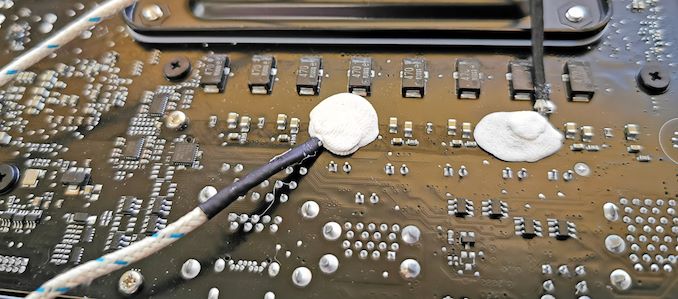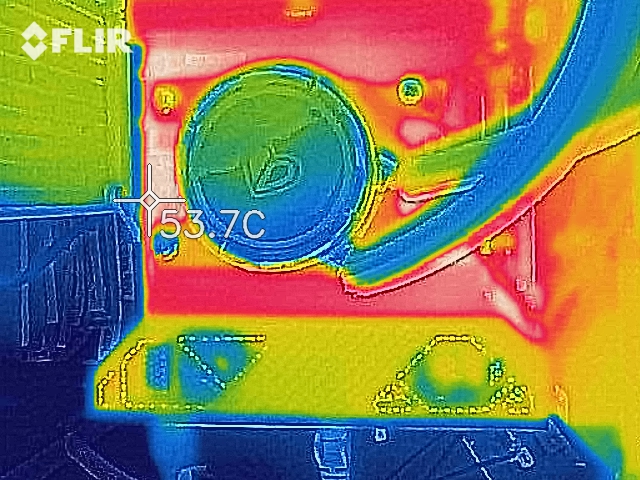The ASUS ROG Crosshair VIII Impact: A Sharp $430 Impulse on X570
by Gavin Bonshor on October 25, 2019 11:30 AM ESTPower Delivery Thermal Analysis
One of the most requested elements of our motherboard reviews revolves around the power delivery and its componentry. Aside from the quality of the components and its capability for overclocking to push out higher clock speeds which in turn improves performance, is the thermal capability of the cooling solutions implemented by manufacturers. While almost always fine for users running processors at default settings, the cooling capability of the VRMs isn't something that users should worry too much about, but for those looking to squeeze out extra performance from the CPU via overclocking, this puts extra pressure on the power delivery and in turn, generates extra heat. This is why more premium models often include heatsinks on its models with better cooling designs, heftier chunks of metal, and in some cases, even with water blocks such as the ASUS ROG Crosshair VIII Formula.

Two K-Type Thermal Probes attached to the rear of the power delivery on the ASUS ROG Crosshair VIII Impact
Testing Methodology
Out method of testing out if the power delivery and its heatsink are effective at dissipating heat, is by running an intensely heavy CPU workload for a prolonged method of time. We apply an overclock which is deemed safe and at the maximum that the silicon on our AMD Ryzen 7 3700X processor allows. We then run the Prime95 with AVX2 enabled under a torture test for an hour at the maximum stable overclock we can which puts insane pressure on the processor. We collect our data via three different methods which include the following:
- Taking a thermal image from a birds-eye view after an hour with a Flir Pro thermal imaging camera
- Securing two probes on to the rear of the PCB, right underneath CPU VCore section of the power delivery for better parity in case a probe reports a faulty reading
- Taking a reading of the VRM temperature from the sensor reading within the HWInfo monitoring application
The reason for using three different methods is that some sensors can read inaccurate temperatures, which can give very erratic results for users looking to gauge whether an overclock is too much pressure for the power delivery handle. With using a probe on the rear, it can also show the efficiency of the power stages and heatsinks as a wide margin between the probe and sensor temperature can show that the heatsink is dissipating heat and that the design is working, or that the internal sensor is massively wrong. To ensure our probe was accurate before testing, I binned 10 and selected the most accurate (within 1c of the actual temperature) for better parity in our testing.
For thermal image, we use a Flir One camera as it gives a good indication of where the heat is generated around the socket area, as some designs use different configurations and an evenly spread power delivery with good components will usually generate less heat. Manufacturers who use inefficient heatsinks and cheap out on power delivery components should run hotter than those who have invested. Of course, a $700 flagship motherboard is likely to outperform a cheaper $100 model under the same testing conditions, but it is still worth testing to see which vendors are doing things correctly.
Thermal Analysis Results

We measured 53.7°C on the hottest part of the board during our testing, the PCB around the VRMs
The ASUS ROG Crosshair VIII Impact is using a 10-phase power delivery with eight Infineon TDA21472 70 A power stages and two TDA21472 70 A power stages for the SoC which are mounted onto the rear of the PCB. The PWM controller of choice is the ASP1405I running in a 4+2 configuration but without doublers. Cooling on the power delivery is expansive with an actively cooled heatsink that has a 30 mm fan integrated into the rear panel cover, and also included a backplate on the rear which incorporates a slim heat pipe into its design. For a small form factor model, this is pretty comprehensive as both the front-mounted CPU section and rear-mounted SoC power stages all have some form of thermal reducing properties to maximise performance.
The results from our power delivery thermal testing put the ASUS ROG Crosshair VIII Impact in good stead for overclockers looking to use this board for high-performance systems. When directly compared to the other small form factor X570 model we've tested, the ASRock X570 Phantom Gaming-ITX/TB3, the Impact power delivery runs around 8°C cooler when comparing the integrated VRM temperature sensors. The performance can be attributed to the small 30 mm cooling fan over the top of the power delivery heatsink, as well as the backplate with a heat pipe integrated negating heat from the front and back. Our external probe reading does seem a little low with a reading of 49°C when compared with previous models on test, but the more heat the heatsinks can remove, the lower the probe temperature should be. The power delivery cooling solution makes the ROG Crosshair VIII Impact the most equipped small form factor board we've seen so far for overclocking Ryzen's 3000 series of processors, and with its high $430 price tag, we wouldn't expect anything less than best-in-class performance; the ASUS ROG Crosshair VIII Impact, in this instance, is certainly that.











59 Comments
View All Comments
gamer1000k - Monday, October 28, 2019 - link
Maybe, but most GPUs are still longer than mini-ITX/DTX motherboards are wide and about the same width as micro-ATX, so a lot of cases will need the extra length for the GPU anyways.NanakiEmi - Monday, October 28, 2019 - link
"the truth is that the mini-DTX size does cancel out any mini-ITX chassis designs, causing the user to look at micro-ATX cases."I'm sorry but I completly disagree with this. I have been waiting for years for Mini-DTX to take off. If you look at most enthusiast ITX cases they are designed for a dual slot GPU. There is nobody who is taking this motherboard and using a basic single slot graphics card.
The extra motherboard space is using the wasted space under the GPU for more features and it makes perfect sence. It it not any wider than ITX is.
Asus even recessed the lower board connctors slightly and made them at right angles to fit your front panel / usb cables in within most ITX case designs.
Frankly this is shody reporting and a complete misunderstanding of the differnce between Mini-ITX and Mini-DTX
KESM - Sunday, March 22, 2020 - link
I agree. I’m going to use this mobo in a Lian Li TU150WX case. This Li Lian ITX case will work with a DTX mobo. Like all mobos you have to bear the responsibility to match the case with the mobo; it’s no different with this mobo or any mobo.I also don’t get the cost argument. If you don’t see value in this board then don’t purchase it. It’s an enthusiast mobo; not targeted for folks seeking a value/economy class mobo.
And finally; you don’t have to have reasoning to purchase it. I just love the way it looks and the fact that it has a riser M2 board and isolation for audio. It offers much in a small form factor. One can elect to purchase any mobo for a variety of reasons.
WaltC - Wednesday, November 6, 2019 - link
Very happy with my Aorus Master x570 that rings the bell @ ~$350; It's been practically problem-free since July 9, when I installed it, through every bios flash GB has put up for download, both beta and official. What I've read suggests that Asus isn't maybe as popular as it once was years ago, and that the quality of the x570 mboards is lacking--but take that with a huge grain of salt as I have no Asus x570 mboards around and haven't used any of them myself.umano - Tuesday, November 19, 2019 - link
This is a great board but with thunderbolt 3 it would have been almost perfect